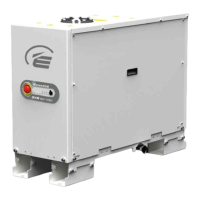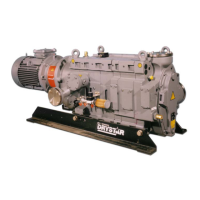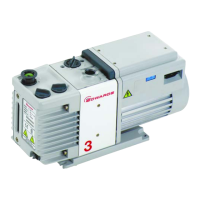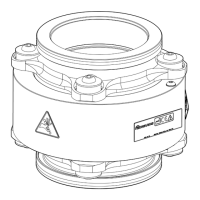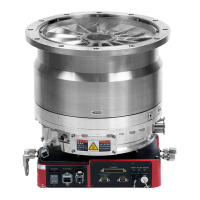M588-00-880 Issue E
Page 22 © Edwards Limited 2015. All rights reserved.
Edwards and the Edwards logo are trademarks of Edwards Limited.
Installation
Dry pumping systems have a maximum continuous exhaust line pressure limit. Operation above the limit may
damage the pumping mechanism.
GXS medium duty dry pumping systems have an exhaust pressure sensor which will initiate warnings and alarms
when the pump is operated for at least 20 seconds above the limits given in Table 24. The pump will continue
to run with a warning present, however an alarm will cause the pump to stop.
GXS light duty dry pumping systems do not have an exhaust pressure sensor. The maximum continuous exhaust
line pressure of these dry pumping systems should not exceed 0.4 barg.
For all pumps, it is the user's responsibility to provide an exhaust system with sufficient conductance to ensure
the exhaust pressure limit is not normally exceeded.
Use a catchpot to prevent the drainage of condensate back into the dry pumping system. Condensate that drains
back into the dry pumping system could damage the pump.
Do not reuse any O-ring or O-ring assembly and do not allow debris to get into the dry pumping system during
installation.
When connecting the dry pumping system to the vacuum system, take note of the following:
To get the best pumping speed, ensure that the pipeline which connects the vacuum system to the dry
pumping system is the minimum length possible and has an internal diameter not less than the system inlet
port.
Ensure that all components in the vacuum pipeline have a maximum pressure rating which is greater than the
highest pressure that can be generated in the dry pumping system.
Incorporate flexible pipelines in the vacuum pipeline to reduce the transmission of vibration and to prevent
loading of coupling joints. Edwards recommend using Edwards braided flexible pipelines. The pipelines
should be rated for 110 °C.
Adequately support vacuum/exhaust pipelines to prevent the transmission of stress to pipeline coupling
joints.
Incorporate a pressure gauge in the inlet pipeline to determine that the dry pumping system operates
correctly.
The dry pumping system inlet must be able to be isolated from the atmosphere and from the vacuum system
if pumping or producing corrosive chemicals.
The outlet of the exhaust pipe can have a check valve fitted which prevents the suck-back of exhaust
vapours after the dry pumping system is shut down. The check valve also provides additional attenuation of
the pulses in exhaust pressure.
For all GXS750 dry pumping systems there is a limit to the length of NW50 pipeline that can be used between
the pump exhaust connection and the facility exhaust. For GXS750 dry pumping systems with a check valve,
the length of pipeline is limited to 1 metre. For GXS750 dry pumping systems without a check valve the
length is limited to 3 metres. If these lengths are exceeded, the GXS750 pump will trip out due to high
exhaust pressure. If the distance to the facility exhaust is greater than these limits, consider using an
adaptor on the pump exhaust and a larger diameter pipeline.
Do not operate the dry pumping system with the exhaust pipeline blocked. If the exhaust pipeline
is blocked, the dry pumping system can generate exhaust pipeline pressures of up to 10 bar
(10 x 10
5
Pa). Note that a pressure spike up to a maximum 15 bar (15 x 10
5
Pa) can be generated
in the exhaust pipeline for less than 0.5 seconds if the inlet is instantaneously exposed to
atmospheric pressure when the pump is running and the exhaust is blocked.
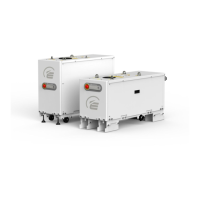
